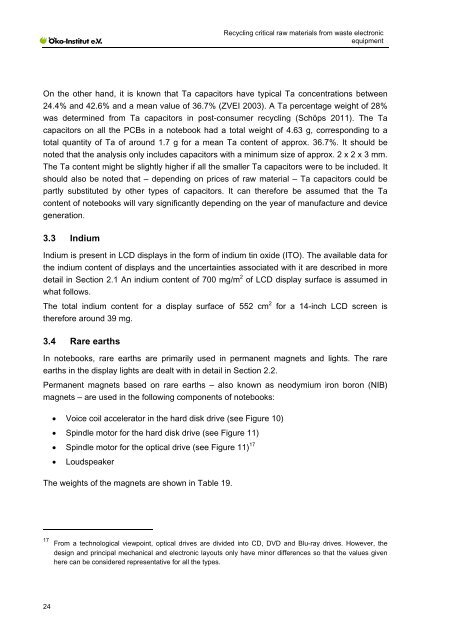Recycling critical raw materials from waste electronic equipment
Recycling critical raw materials from waste electronic equipment
Recycling critical raw materials from waste electronic equipment
Create successful ePaper yourself
Turn your PDF publications into a flip-book with our unique Google optimized e-Paper software.
24<br />
<strong>Recycling</strong> <strong>critical</strong> <strong>raw</strong> <strong>materials</strong> <strong>from</strong> <strong>waste</strong> <strong>electronic</strong><br />
<strong>equipment</strong><br />
On the other hand, it is known that Ta capacitors have typical Ta concentrations between<br />
24.4% and 42.6% and a mean value of 36.7% (ZVEI 2003). A Ta percentage weight of 28%<br />
was determined <strong>from</strong> Ta capacitors in post-consumer recycling (Schöps 2011). The Ta<br />
capacitors on all the PCBs in a notebook had a total weight of 4.63 g, corresponding to a<br />
total quantity of Ta of around 1.7 g for a mean Ta content of approx. 36.7%. It should be<br />
noted that the analysis only includes capacitors with a minimum size of approx. 2 x 2 x 3 mm.<br />
The Ta content might be slightly higher if all the smaller Ta capacitors were to be included. It<br />
should also be noted that – depending on prices of <strong>raw</strong> material – Ta capacitors could be<br />
partly substituted by other types of capacitors. It can therefore be assumed that the Ta<br />
content of notebooks will vary significantly depending on the year of manufacture and device<br />
generation.<br />
3.3 Indium<br />
Indium is present in LCD displays in the form of indium tin oxide (ITO). The available data for<br />
the indium content of displays and the uncertainties associated with it are described in more<br />
detail in Section 2.1 An indium content of 700 mg/m 2 of LCD display surface is assumed in<br />
what follows.<br />
The total indium content for a display surface of 552 cm 2 for a 14-inch LCD screen is<br />
therefore around 39 mg.<br />
3.4 Rare earths<br />
In notebooks, rare earths are primarily used in permanent magnets and lights. The rare<br />
earths in the display lights are dealt with in detail in Section 2.2.<br />
Permanent magnets based on rare earths – also known as neodymium iron boron (NIB)<br />
magnets – are used in the following components of notebooks:<br />
� Voice coil accelerator in the hard disk drive (see Figure 10)<br />
� Spindle motor for the hard disk drive (see Figure 11)<br />
� Spindle motor for the optical drive (see Figure 11) 17<br />
� Loudspeaker<br />
The weights of the magnets are shown in Table 19.<br />
17 From a technological viewpoint, optical drives are divided into CD, DVD and Blu-ray drives. However, the<br />
design and principal mechanical and <strong>electronic</strong> layouts only have minor differences so that the values given<br />
here can be considered representative for all the types.

















